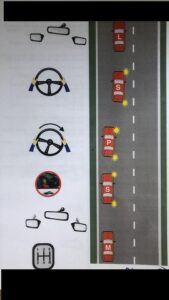Moving Off From A Parked Position

The ability to move off from a parked position is key in passing your driving test. This manoeuvre is completed 4 times during the test without the student even realizing it. Many people actually fail there test by not doing this manoeuvre properly. There are so many possible hazards when you are moving out and we will cover the main ones today.
From the diagram above we see the letters MSPSL. These letters stand for Mirrors, Signal, Manoeuvre, Speed and Look. As the diagram suggests the car must be put into gear. Usually, you would move out of a parking area in 1st gear.
Mirrors. Once the car is in 1st gear, we then check our blind spots and our mirrors. It is so important that you check these areas for a number of reasons. First, you check your blind spot out the passenger window. You are looking for any potential hazards from pedestrians to small animals. Next is your passenger side wing mirror. Checking this mirror will show you if you have anything coming up behind you on the footpath. Next is you inside rearview mirror. This mirror tells you what is coming up from behind. Next is your driver side wing mirror. When moving out from a parked position this mirror is so important as it shows you what’s coming up from behind you. This could be anything from moving traffic to cyclists. Next is your blind spot. To check this turn your head and look out the driver-side window. The blind spot check is so important as it warns you of any potential hazards coming from the side. Again this could be a pedestrian or a cyclist or a number of different scenarios.
Signal. After your blind spot and mirror check, if the way is clear, signal your intention. In other words, indicate in the direction you are moving out. If there are lots of cyclists and cars coming, don’t indicate right away as you could potentially make a cyclist swerve into the line of traffic. Wait until you see a safe gap in the traffic coming up, then signal your intention.
Manoeuvre. Once it is safe to do so, pull out from your parking position. Looking into the road ahead, position your car safely so you are not in the middle of the road or too close to potential parked cars on the left. Position your car so you are not constantly weaving in and out of potential hazards.
Speed. If the road ahead is clear, accelerate the car up to the speed limit on the street you are driving on. In your driving test, the examiner really wants to see your progress and will penalize you for driving slowly. So don’t be shy and get your car up to the speed limit.
Look. Now you are in a great position on the road. Look into the road ahead and examine the road for potential hazards. this could be a number of things like pedestrian crossings or speed ramps. Negotiating potential hazards before you get to them is vital. You can adjust speed and position the car safely long before you reach the hazard. This will avoid harsh braking and swerving in and out of parked cars.
This is a very important aspect of the driving test and it is vital to practice these every time you move out from a parked position.



